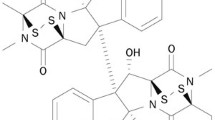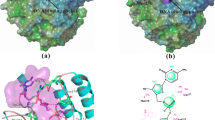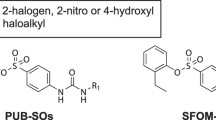Abstract
Purpose: Aminoflavone (5-amino-2,3-fluorophenyl)-6,8-difluoro-7-methyl-4H-1-benzopyran-4-one; AF; NSC 686288) is a novel anticancer agent with a unique pattern of growth inhibitory activity in the National Cancer Institute (NCI) 60 tumor cell line screen. Phase I clinical trials with AF will begin soon. We previously demonstrated extensive metabolism of AF by cytochrome P450 (CYP) 1A1 and CYP1A2, metabolic activation, formation of irreversible protein and DNA adducts and p53 stabilization in sensitive, but not resistant, human tumor cell lines treated with AF [9]. The present studies focus on the effects of AF on cellular DNA and cellular responses to DNA damage. Methods: Phosphorylation of H2AX in MCF7 cells treated with AF was determined with immunofluorescence. MTS (3-(4,5-dimethylthiazol-2-yl)-5-(3-carboxymethoxyphenyl)-2-(4- sulfophenyl)-2H-tetrazolium) assays were used to determine the effect of cotreatment with caffeine or wortmannin, inhibitors of ataxia-telangiectasia-mutated protein (ATM) and ATR (ATM- and rad3-related protein), on the AF IC50 values for MCF7 cells. DNA damage in MCF7 cells treated with AF was determined by alkaline elution. DNA-topoisomerase complex stabilization was ascertained by the ICE (in vitro complex of enzyme) assay. Results: Treatment of sensitive cells with AF resulted in phosphorylation of H2AX, a histone 2A variant that is phosphorylated in response to DNA damage. AF IC50 values for MCF7 cells were lowered by cotreatment with caffeine or wortmannin, further implicating DNA damage in AF cytotoxicity. There was no evidence of DNA–DNA cross-linking in sensitive cells, but protein-associated single-strand breaks were observed after AF treatment. Although this pattern of DNA damage is commonly associated with topoisomerase poisons, there was no evidence for AF-induced stabilization of either topoisomerase I- or II-DNA complexes. Conclusions: These studies further implicate DNA damage in the cytotoxicity of AF and identify biochemical features of that damage including formation of protein-associated single-strand breaks not involving topoisomerase I or II.





Similar content being viewed by others
References
Abraham RT (2001) Cell cycle checkpoint signaling through the ATM and ATR kinases. Genes Dev 15(17):2177–2196
Akama T, Shida Y, Sugaya T, Ishida H, Gomi K, Kasai M (1996) Novel 5-aminoflavone derivatives as specific antitumor agents in breast cancer. J Med Chem 39:3461–3469
Alley MC, Stinson SF, Pacula-Cox CM, Camalier RF, Phillips LR, Daw TW, Sausville EA (1999) Pharmacologic evaluations of a novel amino-substituted flavone (NSC 686288) exhibited unique in vitro and in vivo anticancer activities. Proc Am Assoc Cancer Res 40:119
Aune GJ, Furuta T, Pommier Y (2002) Ecteinascidin 743: a novel anticancer drug with a unique mechanism of action. Anticancer Drugs 13(6):545–55
Cushman M, Zhu H, Geahlen RL, Kraker AJ (1994) Synthesis and biochemical evaluation of a series of aminoflavones as potential inhibitors of protein-tyrosine kinases p561cd, EGF4, and p60v-src. J Med Chem 37:3353–3362
Ferriola PC, Cody V, Middleton E Jr (1989) Protein kinase C inhibition by plant flavonoids: kinetic mechanisms and structure-activity relationships. Biochem Pharmacol 38:1617–1624
Khan QA, Kohlhagen G, Marshall R, Austin CA, Kalena GP, Kroth H, Sayer JM, Jerina DM, Pommier Y (2003) Position-specific trapping of topoisomerase II by benzo[a]pyrene diol epoxide adducts: implications for interactions with intercalating anticancer agents. Proc Natl Acad Sci USA 100(21):12498–503
Kohn KW, Ewig RA, Erickson L, Zweeling L (1981) Measurement of strand breaks and crosslinks in DNA by alkaline elution. In: Friedberg EC, Hanawalt PC (eds) DNA Repair: a laboratory manual of research techniques. 379 p
Kuffel MJ, Schroeder JC, Pobst LJ, Naylor S, Reid JM, Kaufmann SH, Ames MM (2002) Activation of the antitumor agent aminoflavone (NSC 686288) is mediated by induction of tumor cell cytochrome P450 1A1/1A2. Mol Pharmacol 62(1):143–153
Liu LF, Rowe TC, Yang L, Tewey KM, Chen GL (1983) Cleavage of DNA by mammalian DNA topoisomerase II. J Biol Chem 258(24):15365–15370
Mao Y, Okada S, Chang LS, Muller MT (2000) p53 dependence of topoisomerase I recruitment in vivo. Cancer Res 60(16):4538–4543
Nelson EM, Tewey KM, Liu LF (1984) Mechanism of antitumor drug action: poisoning of mammalian DNA topoisomerase II on DNA by 4′-(9-acridinylamino)-methanesulfon-m-anisidide. Proc Natl Acad Sci USA 81(5):1361–1365
Nielsen SE, Breinholt V, Justensen U, Cornett C, Dragsted LO (1998) In vitro biotransformation of flavonoids by rat liver microsomes. Xenobiotica 28(4):389–401
Pommier Y, Kohlhagen G, Laco GS, Kroth H, Sayer JM, Jerina DM (2002) Different effects on human topoisomerase I by minor groove and intercalated deoxyguanosine adducts derived from two polycyclic aromatic hydrocarbon diol epoxides at or near a normal cleavage site. J Biol Chem 277(16):13666–13672
Pommier Y, Schwartz RE, Zwelling LA, Kerrigan D, Mattern MR, Charcosset JY, Jacquemin-Sablon A, Kohn KW (1986) Reduced formation of protein-associated DNA strand breaks in Chinese hamster cells resistant to topoisomerase II inhibitors. Cancer Res 46(2):611–616
Rogakou EP, Pilch DR, Orr AH, Ivanova VS, Bonner WM (1998) DNA double-stranded breaks induce histone H2AX phosphorylation on serine 139. J Biol Chem 273(10):5858–5868
Sarkaria JN, Busby EC, Tibbetts RS, Roos P, Taya Y, Karnitz LM, Abraham RT (1999) Inhibition of ATM and ATR kinase activities by the radiosensitizing agent, caffeine. Cancer Res 59(17):4375–4382
Sarkaria JN, Tibbetts RS, Busby EC, Kennedy AP, Hill DE, Abraham RT (1998) Inhibition of phosphoinositide 3-kinase related kinases by the radiosensitizing agent wortmannin. Cancer Res 58(19):4375–4382
Shi Q, Chem K, Morris-Natschke SL, Lee KH (1998) Recent progress in the development of tubulin inhibitors as antimitotic antitumor agents. Curr Pharm Des 4:219–248
Szmigiero L, Erickson LC, Ewig RA, Kohn KW (1984) DNA strand scission and cross-linking by diaziridinylbenzoquinone (diaziquone) in human cells and relation to cell killing. Cancer Res 44(10):4447–4452
Takebayashi Y, Goldwasser F, Urasaki Y, Kohlhagen G, Pommier Y (2001) Ecteinascidin 743 induces protein-linked DNA breaks in human colon carcinoma HCT116 cells and is cytotoxic independently of topoisomerase I expression. Clin Cancer Res 7(1):185–191
Takebayashi Y, Pourquier P, Zimonjic DB, Nakayama K, Emmert S, Ueda T, Urasaki Y, Kanzaki A, Akiyama SI, Popescu N, Kraemer KH, Pommier Y (2001) Antiproliferative activity of ecteinascidin 743 is dependent upon transcription-coupled nucleotide-excision repair. Nat Med 7(8):961–966
Trask DK, Muller MT (1988) Stabilization of type I topoisomerase-DNA covalent complexes by actinomycin D. Proc Natl Acad Sci USA 85(5):1417–1421
Ward IM, Chen J (2001) Histone H2AX is phosphorylated in an ATR-dependent manner in response to replicational stress. J Biol Chem 276(51):47759–47762
Weinstein JN, Myers TG, O’Connor PM, Friend SH, Fornace AJ Jr, Kohn KW, Fojo T, Bates SE, Rubinstein LV, Anderson NL, Buolamwini JK, van Osdol WW, Monks AP, Scudiero DA, Sausville EA, Zaharevitz DW, Bunow B, Viswanadhan VN, Johnson GS, Wittes RE, Paull KD (1997) An information-intensive approach to the molecular pharmacology of cancer. Science 275(5298):343–349
Yamashita Y, Kawada S, Nakano H (1990) Induction of mammalian topoisomerase II dependent DNA cleavage by nonintercalative flavonoids, genistein and orobol. Biochem Pharmacol 39:737–744
Zhai S, Dai R, Friedman FK, Vestal RE (1998) Comparative inhibition of human cytochromes P450 1A1 and 1A2 by flavonoids. Drug Metab Dispos 26(10):989–992
Acknowledgements
The authors wish to thank Dr. Junjie Chen for generously providing the γ-H2AX antibody. This work was funded by a Mary Kay Ash Foundation Grant (MMA) and the Mayo Comprehensive Cancer Center (CA15083).
Author information
Authors and Affiliations
Corresponding author
Rights and permissions
About this article
Cite this article
Pobst, L.J., Ames, M.M. CYP1A1 activation of aminoflavone leads to DNA damage in human tumor cell lines. Cancer Chemother Pharmacol 57, 569–576 (2006). https://doi.org/10.1007/s00280-005-0075-7
Received:
Accepted:
Published:
Issue Date:
DOI: https://doi.org/10.1007/s00280-005-0075-7




